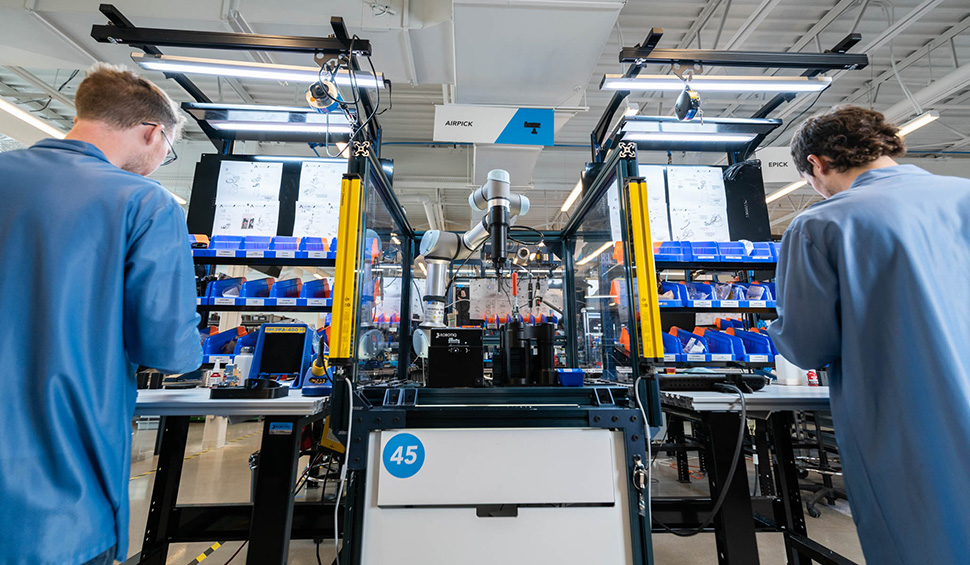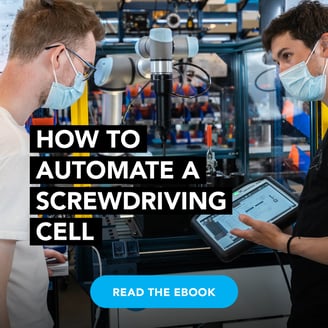How to Appraise Potential Tasks for Robotic Screwdriving

How can you tell if a particular screwdriving application will be suitable for robotic automation?
Maybe you want your robot to screw down circuit boards for electronic assembly. Maybe the robot will be fixing parts into a car or assembling appliances.
Whatever your screwdriving needs, there are 7 properties you should consider when appraising potential tasks. By looking at your potential tasks with relation to these properties, you will set yourself up for success with your robotic automation project.
Why the most pressing screwdriving task isn't always best
You likely have one or more screwdriving tasks in mind that you think might make good candidates for robotic screwdriving.
Perhaps a particular screwdriving task takes a disproportionate amount of time from your human operators. There are many other tasks that these people could be doing, but they are always tied up with this one screwdriving task.
Your most pressing tasks certainly could be a good option for robotic, but not necessarily.
Some screwdriving operations are easier to automate with a robot than others. Your bottleneck screwdriving task might be simple to automate, but it might not.
You will do yourself and your team a lot of favors by choosing the right task from the start.
Want to automate a screwdriving task?
The key to picking the right task for robotic screwdriving
When starting out with robotic screwdriving, it's useful to keep 2 factors in mind:
- Simplicity — How simple or complex is the task to automate?
- Impact — How significant will the impact of automation be on your business?
You can assess any potential robotic task by looking at it through the lens of "simplicity vs impact." The properties listed below can help you to appraise potential tasks through this lens.
7 properties of a suitable robot screwdriving task
Let's say that you have quite a few screwdriving tasks that could be suitable for robotic automation.
How do you distinguish between them? What properties indicate that a task will be a good candidate for robotic screwdriving?
Here are 7 properties that we look for when we are assessing potential tasks:
1. The part can be fixtured
When a human performs a screwdriving task, they can usually use their other hand to steady the workpiece at the same time. This is not easy for a robot to do — it would require something like a second robot arm or actuator to hold the piece.
For your first screwdriving project, it's a good idea to choose a task where the part can be fixtured. This makes it easy for the robot to perform the screwing operation.
2. The task is simple
As discussed above, it's much better to go for a simple task first. It is certainly possible to add many "bells and whistles" to your robot setup — accessories and extras which can be necessary for some specific tasks. But, the simplest setup possible is almost always the best option for your first screwdriving project.
Once you've gained some more experience with collaborative robotics, you may start to identify areas where more complexity could be helpful. By then, you'll be more familiar with robot deployments and the integration will be easier.
3. Only one human is replaced
You might envision changing out all of your screwdriving operators for robotic automation. After all, there are probably many more useful tasks that your team can be doing than just inserting screws!
While you may introduce more screwdriving robots later, it's better to just start by replacing just one person's screwdriving operation. That way, the impact on production will be smaller and everyone will gradually get used to the idea of using robots.
4. Uses a single type of screw
It's certainly possible to use multiple types of screw in a robotic screwdriving operation. However, this requires you to do tool changeovers to switch between the screw types, which means adding extra tools and integrating them with the robot.
In the interests of starting simple, it's better to start with a task that only uses one type of screw. When this task has been operating successfully for some time, you can think about adding the capability for changeovers.
5. You have operator buy-in
The idea of being "being replaced by a robot" worries quite a lot of people. This can make people resistant to accepting a robot, even if it will ultimately improve the quality of their job.
For this reason, it's a good idea to get buy-in from your operators before you bring the robot into the workplace. That way, those people will become active contributors in the robot deployment, which is necessary for any successful robotic screwdriving project.
6. Additional floorspace is available
Collaborative robots don't take up much space compared to conventional industrial automation. However, a screwdriving robot still needs a certain amount of extra floorspace compared to manual screwdriving.
If a particular screwdriving task is very tight on floorspace, think about how you could move that task to another area of your facility or start with a task that has slightly more space flexibility.
7. Has a high impact
Your first robot project is almost always the most challenging when it comes to convincing others to adopt robotic automation. Once you have one or two robot deployments under your belt, people already recognize the benefits and return on investment that robots bring.
With your first robot screwdriving application, pick a task that will have a high impact on your operations. That way, the benefits will be as clear as possible to everyone.
Where to find the right application kit
When you've picked a suitable screwdriving task, what's the best way to deploy it quickly?
The right application kit will help you to get up and running as quickly and easily as possible. Application kits include all the robotic components and extras that you need for screwdriving.
Check out our solutions page for details of our screwdriving application kit.
What screwdriving tasks have you been considering for robotic automation? Tell us in the comments below or join the discussion on LinkedIn, Twitter, Facebook, or the DoF professional robotics community.









Leave a comment